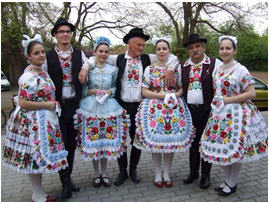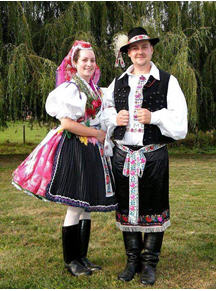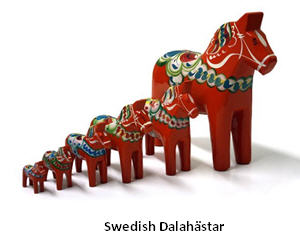Krisztina Varsányi - 07.02.2018 16:03
Volkskunst als kulturelle Eigenart: Veraltet oder Schatz? / Folk art or cultural peculiarities: outdated or treasure?
Villő Ilosfalvi - 15.04.2018 11:24
Folk art: outdated or treasure?
by Villő Ilosfalvi, DNG Budapest/Hungary
Folk art ecompasses art produced from an indigenous culture or by peasants or other laboring tradespeople. In contrast to fine art, folk art is primarily utilitarian and decorat ive rather than purely aesthetic. Folk Art is characterized by a naive style, in which traditional rules of proportion and perspective are not employed. Art branches included: folk poetry, folk music, folk dance, folk costumes, folk ornaments. Still some of the schools consider important to give the pupils more knowledge about customs of an ethnic group. This includes the music lesson where we learn to sing old Swabian songs. The dancing lesson where Swabian dances are taught. Finally, we wear Swabian costumes on special occasions at school. However, I agree with those of my schoolmates who think that all of these customs and traditions are not reflecting our century, so these are outdated. The songs that we sing are performed in old Swabian language, because they were written when people talked like this. I would agree that these songs are really old-fashioned, but they still carry and reflect the feelings of our ancestors, preserve lasting memories. That might be so precious to us. The traditional clothes that people used to wear and on some occasions still wear in some small villages don’t suit us any more.
However, this doesn’t mean that we don’t like them. We want to show our clothes, the ones especially our grandmothers once wore, on an event when everybody is dressed in traditional Swabian outfit. Our generation has better chances than our ancestors had. We have more options where to travel, there are plenty of things to do. Still traditions offer a chance to say “thank you” for the contribution that someone has made, tradition brings families together and enables people to reconnect with friends.


In vain we think that traditions are outdated we need them to understand our past and to build our future.
Picture 1: Marta Bolla (pinterest)
Picture 2: Katalin Horváthné (pinterest)
April 5, 2018 15.53 PM
nicolas löwe - 16.04.2018 21:32
Dies ist mein Beitrag zu dem Thema
Folk art: outdated or treasure

To discuss the subject of folk art we first have to define it. So what is folk art? There is no one definition for it but the term is often used to describe art that is primarily made by a certain community/folk, is often handmade (when it comes to materialistic art) and is traditionalistic; reflecting shared cultural aesthetics and social issues.
So now that I’ve loosely defined what Folk art is I can express my thoughts on if its outdated or treasure. I think that folk art is a valuable asset to a country or community. Folk art shows both a cultures history and traditions but can also be reinvented and mixed with new influences. In my opinion folk art is a great way to show others what your country or culture stands for. It is important to remember that culture is something that is supposed to be shared and reinvented, and it's the same thing with art. Modern art doesn’t diminish the cultural value of traditional art and that's something that should be remembered when discussing folk art. The way I see it is that art doesn’t become outdated nor does it lose its value.
One of Sweden's most known folk art forms I’d like to introduce you to is the Dalahäst (as seen in the picture above).The Dalahäst (literally Dala horse) comes from the Swedish county Dalarna. The Dalahäst is a traditional hand carved wooden horse originally used as a toy for children. Nowadays the Dalahäst is mostly used as a decoration and has become a well known symbol of Dalarna and Sweden. The patterns and shape of the Dalahäst change based on in which part of Dalarna it is produced. Although the most common is the red one pictured above.
Nicolas Löwe
Stella Ujma - 26.04.2018 16:14
Hey Nicolas,
I couldn`t agree more with your article. For me, folk art is a great way to get to know a different country and helps to understand it. Often, there`s a nice story attached to it, which makes it even more interesting. I also agree with what you said about sharing traditions. Many people think that a tradition is just for itself but I think this is really the wrong point of view. Why should you keep everything to yourself, when you could share it with so many people who could learn from it. I myself like to learn new thinks about a country so I think it would be really sad if we just kept every tradition and story about our country to ourselves.
Wiktoria Gawlikowska - 13.05.2018 21:07
Ich habe eure Aussagen gelesen und kann sagen, dass ich derselben Meinung wie ihr bin. Die Volkskunst ist heutzutage ein bisschen unzeitgemäß und veraltet. Die zu uns aus anderen Ländern als Folgen der Globalisierung kommenden fremden Kulturen verursachen, dass unsere Volkskunstschätze langsam in Vergessenheit geraten. Zweifellos bleibt das auch im Zusammenhang damit, dass die Volkskultur sich hauptsächlich auf dem Dorf entwickelt hat. In heutigen Zeiten übernehmen die Dörfer die städtischen Vorlagen und Lebensmuster. Infolgedessen verliert die Volkskunst an Bedeutung und wird immer mehr zurückgewiesen.
Als Beispiel kann ich die Volkstracht nennen, die immer häufiger nur bei den Festen und Feiern getragen wird, nicht jeden Sonntag wie früher, wenn man diese in die Kirche trug. Auch Krakauer Volkstracht sieht man auf dem Marktplatz nur bei den besonderen Gelegenheiten. Die bunt verzierten Volkshäuser findet man hingegen lediglich in den Freilichtmuseen. Mit meinen Eltern habe ich einige Ortschaften besichtigt, wo man vor allem in den Kirchen die Volkskunst bewundern konnte. Das ist vor allem im nordöstlichen Polen und äußert sich am meisten in den Abbildern des Gottes, der Gottesmutter, oder der Heiligen. Ähnliche und andere Kunsthandwerke wie Holzskulpturen und Schnitzerzeugnisse, handgeschmücktes Keramikgeschirr, Glasmalereien und bestickte und gestrickte Tischdecken und Servietten oder verschiedene Kleidungstücke kann man auch in Tuchhallen auf dem Krakauer Marktplatz kaufen. Die meisten sind von guter Qualität, aber leider teuer.
Schade, dass man solche handgemachte Volkskunstwerke nicht mehr am Alltag benutzt und die Menschen stark von den ausländischen Kulturen begeistert sind. Die Volkskultur verschwindet vielleicht nicht ganz aus unserem Alltagsleben, aber ihre Auswirkung nimmt im groβen Grade ab. Man soll doch nicht vergessen, dass die Tradition sehr wichtig ist, weil wir diese von unseren Vorfahren geerbt haben. Deshalb sollen wir uns darum kümmern und das schützen.